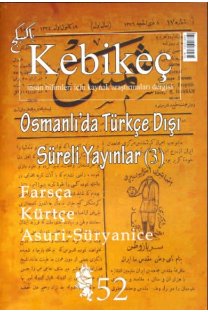Dünden Bugüne Sıla ile Gurbet Arasında Alevi Coğrafyası Üzerine
___
Agnew, John. (1994), “The territorial trap: The Geographical Assumptions of International Relations Theory”, Review of International Political Economy, 1 (1): 53-80.Andrews, Peter Alford. (1989), Ethnic groups in the Republic of Turkey. Wiesbaden: Verlag. Arık, Remzi Oğuz. (1969), Coğrafyadan Vatana. İstanbul: Milli Eğitim Basımevi.
Atay, Tayfun. (2005), Göl ve insan: Beyşehir Gölü çevresi doğa-kültür ilişkisi üzerine antropolojik bir inceleme. Ankara: Kalan Yayınları.
Aydın, Ali. (2005), Aşiretim Sinemili Köyüm Bozhöyük. İstanbul: Can Yayınları.
Aydınoğlu, A.Ç., Yıldırım, V. ve Özendi, M. (2007), “Ulusal Tabanlı Adres Bilgi Sistemi için İdari Birim Yapısının Konumsal Modellenmesi”, TMMOB Harita ve Kadastro Mühendisleri Odası, 10. Türkiye Harita Bilimsel ve Teknik Kurultayı, 02-06 Nisan 2007, Ankara.
Beller-Hann, Ildiko ve Chris Hann. (2001), Turkish Region: State, market and social identities on the East Black Sea coast. Oxford: James Currey. (Türkçe Basım: 2012, Doğu Karadeniz'de Devlet, Piyasa, Kimlik İki Buçuk Yaprak Çay. İstanbul: İletişim)
Canbakal, Hülya. (2005), “An Exercise in Denominational Geography in search of Ottoman Alevis”, Turkish Studies, 6 (2): 253-271.
Delaney, Carol Lowery. (1991), The seed and the soil: gender and cosmology in Turkish village society. London: University of California Press.
Deniz, Dila. (2016), “Dersim’de Su Kutsiyeti, Mizur/Munzur Nehri İlişkisi, Anlamı ve Kapsamı ile Baraj/HES Projeleri,” Sudan Sebepler: Türkiye’de Neoliberal Su-Enerji Politikaları ve Direnişler, der. Cemil Aksu, Sinan Erensü, Erdem Evren, İstanbul: İletişim: 177-198.
Hasluck, F.W. (1915), “Geographical distribution of the Bektashi”, the Annual of the Birth School at Athens, 21: 84-124.
Fırat, Fero. (2008), Varto’da çocuk olmak. Istanbul: Piya.
Gezik, Erdal. (2004), Dinsel, etnik ve politik sorunlar bağlamında Alevi Kürtler, Ankara: Kalan Yayınları.
Gronhaug, Reidar. (1974), Micro-Macro relations: Social organization in Antalya, Southern Turkey. Bergen: Social Anthropology Studies, No. 7.
Gültekin, Ahmet Kerim (2004), Tunceli’de Kutsal Mekân Kültü. Ankara: Kalan.
Hasluck, F.W. (1915), “Geographical distribution of the Bektashi”, the Annual of the Birth School at Athens, 21: 84-124.
Jongerden, Joost. (2009), “Crafting Space, Making People: the Spatial Design of Nation in Modern Turkey”, European Journal of Turkish Studies, 10: 2-21.
Martins, Herminio. (1974), “Time and theory in sociology”, ed. John Rex, Approaches to Sociology: An introduction to major trends in British Sociology, London: Routledge & Kegan Paul: 246-294 . Nişanyan, Sevan. (2011), Hayali coğrafyalar: Cumhuriyet döneminde Türkiye’de değiştirilen yer adları. İstanbul: TESEV.
Öktem, Kerem. (2008), “The Nation’s Imprint: Demographic Engineering and the Change of Toponymes in Republican Turkey”, European Journal of Turkish Studies, 7: 1-33.
Sanal, Recep. (1998), “Tarihi Gelişimi İçerisinde Türk Anayasalarında Genel Yönetimin Taşra Örgütüne İlişkin Düzenlemeler ve Yönetim Desenindeki Değişmeler”, Atatürk Yolu Dergisi, 6, Ankara Üniversitesi Türk İnkılâp Tarihi Enstitüsü: 22.
Sanal, Recep. (2000), Türkiye’de İllerin Yeniden Düzenlenmesi, Ankara: T.C. İçişleri Bakanlığı- Araştırma, Planlama ve Koordinasyon Kurulu Başkanlığı.
Shankland, David. (2003), The Alevis in Turkey: The Emergence of a Secular Islamic Tradition, London: Routledge Curzon.
Shankland, David. (2010), “Maps and the Alevis on the Ethnography of Heterodox Islamic Groups”, British Journal of Middle Eastern Studies, 37 (33): 227-239.
Smith, Anthony D. (1979), Nationalism in the twentieth century, Oxford: Martin Robertson.
Sökefeld, Martin ve Susanne Schwalgin. (2000), “Institutions and their agents in diaspora: A comparison of Armenians in Athens and Alevi in Germany”, the 6th European Association of Social Antropologist Conference, Krakau, 26-9 Temmuz 2000.
Sökefeld, Martin. (2002), “Alevi Dedes in the German Diaspora: The Transformation of a Religious Institution”, Zeitschrift für Ethnologie, 127: 163-186.
Sökefeld, Martin. (2008), Struggling for recognition: The Alevi movement in Germany and in transnational space, Oxford: Berghan Books.
Stirling, Paul. (1965), Turkish village. London: Weidenfeld and Nicolson.
Swyngedouw, E. (2004) “Globalisation or ‘Glocalisation’? Networks, Territories and Rescaling”, Cambridge Review of International Affairs, 7 (11): 25-47.
Toprak, Zafer. (2012), Darwin’den Dersim’e Cumhuriyet ve Antropoloji. İstanbul: Doğan Kitap.
Tosun, Halis. (2002), Alevi kimliğiyle yaşamak. İstanbul: Can Yayınları.
Ülger, Ali Haydar. (2007), Dünden bugüne Kırkısrak. Muğla: Tülkan.
Van Bruinessen, Martin. (1996), “Kurds, Turks and the Alevi Revival in Turkey”, Minorities in the Middle East: Power and the Politics of Difference, 200: 7-10.
Vorhoff, Karin. (1998), “‘Let’s Reclaim Our History and Culture’: Imagining Alevi Community Contemporary Turkey”, Die Welt des Islams, 38 (2): 220-252.
Zebil, Selman. (2009), Şamlar Köyü. İstanbul: Yazıt.
Zırh, Besim Can (2008), “Euro-Alevis: From Gasterbeiter to Transnational Community”, ed. Anghel, Gerharz, Rescher ve Salzbrunn The Making of World Society: Perspectives from Transnational Research, Verlag-Transcript: 103-130.
Zırh, Besim Can (2012), “Following the Dead Beyond the ‘Nation’: A Map for Transnational Alevi Funerary Routes from Europe to Turkey,” Ethnic and Racial Studies, 35 (10): 1758-1774.
- ISSN: 1300-2864
- Yayın Aralığı: 2
- Başlangıç: 1995
- Yayıncı: Mehtap Yüksel
Osmanlı Tefrika Çalışmalarında Göz Ardı Edilen Bir Kaynak: Karamanlıca Anatoli Gazetesi
Antalya’da Eşraf, Siyaset ve II. Meşrutiyet
Doğu Anadolu'da Batılı Seyyahlar 1800-1914 Açıklamalı Bibliyografya Denemesi
Dünden Bugüne Sıla ile Gurbet Arasında Alevi Coğrafyası Üzerine
Dersim Külliyatında Ayrıksı İki Roman
Erken Cumhuriyet DönemindeUlus İnşası ve Tarihî Romanlar: Savaşçı, Medeni ve Millî Kahraman
Ev: Feminist Coğrafya, Orta Doğu ve Namüsait Kesişimler
Kayıp Köylere Mekansal Bakış: XVI-XX. Yüzyıl Konya Çevresi Örneği
Geç Osmanlı ve Erken Cumhuriyet Dönemleri Anadolu Florası Çalışmalarının Öncülerinden
